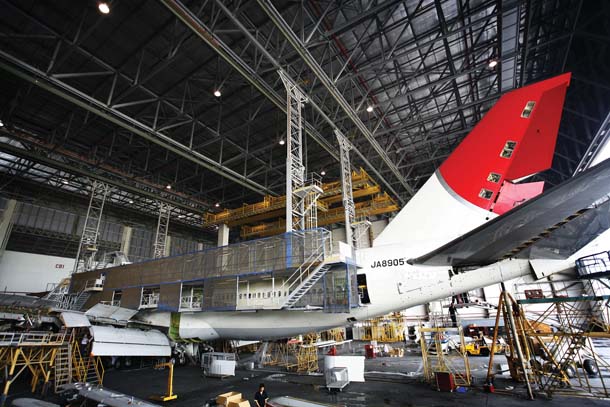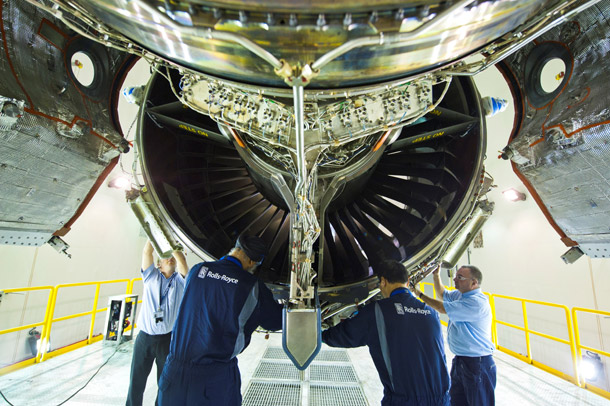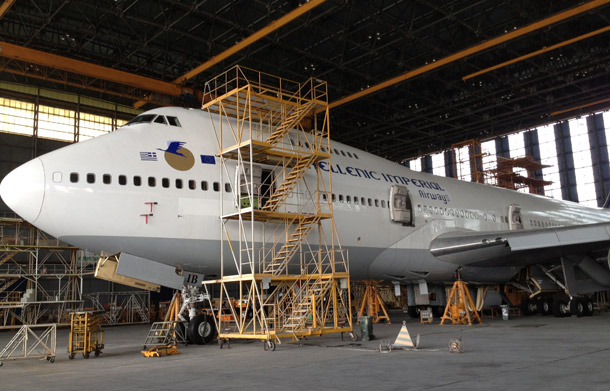Southeast Asian companies have an increasingly visible present in the airline industry, as established names, and several new ones, look to benefit from growing demand. Traditionally, many of them concentrated on provision of maintenance, repair and overhaul (MRO) services. Today, they are expanding into areas such as pilot training and the production of aircraft components with the aim of becoming tier-one or tier-two suppliers themselves.
Existing MROs in the region are also expanding facilities to absorb more work and grow their presence. Take ST Aerospace. When the Singapore-based MRO started out in 1975, it focused on military contracts such as refurbishment of the Douglas A-4 Skyhawk. Today, commercial business makes up 70% of its S$1.8 billion ($1.4 billion) average annual revenue. With eyes fixed on expanding its facilities and capabilities in China, Panama and San Antonio, Texas, the MRO now also wants to enter the business aviation sector at home in Singapore, where the Seletar Aerospace Park (SAP) is being developed.
 |
|---|
| © ST Aerospace |
Plans are already in the pipeline to tear down a helicopter hangar on its Seletar site to make room for a bigger hangar dedicated to general aviation, says ST president Chang Cheow Teck. ST also wants to add more corporate jets to its charter service. "With the SAP, we believe there will be growth in general aviation for us," says Chang.
The MRO has 30 widebody and 31 narrowbody bays worldwide, with nine widebody and 11 narrowbody bays in Singapore alone. Last year, ST Aerospace delivered 472 aircraft to customers after airframe maintenance and modifications, serviced 262 engines and 53,200 components, and completed 18 passenger-to-freighter conversions.
Looking at the economic uncertainties in Europe, Chang expects 2012 to be "a tight year where we have to stay nimble to grow profits". He does not see huge growth for MROs in Southeast Asia since airlines in the region are consolidating, but believes the key is to have "world-class processes and people", to differentiate itself from the masses.
Asked about airlines such as Jetstar and Sriwijaya planning to set up maintenance facilities, Chang says he does not feel particularly threatened. "In Asia most airlines are not very rational; they all want their own facilities. But these facilities, their main focus is on serving the airline so they are only out on the market on a sporadic basis. So at the end of the day, the competition is marginal," he says.
"The mature players coming to this part of the world such as Lufthansa Technik Philippines and Air France-KLM, they are more formidable players, I think."
Lufthansa Technik Philippines has just completed construction of its third and largest hangar, which can house the Airbus A380. While it will start its first A380 project with a cabin modification in April, the ultimate aim is to obtain certifications to perform C-checks, says its vice-president for marketing and sales Dominik Wiener-Silva.
WORKLOAD SPILLOVER
Richard Budihadianto, president and chief executive of Garuda Indonesia's maintenance arm GMF AeroAsia (see box), argues there is huge potential for growth of MROs in Indonesia. Local airlines spent $800 million on aircraft maintenance last year, and he expects the figure to grow to $2 billion by 2015.
Last year, GMF absorbed $180 million of these maintenance contracts, but the combined total with other local companies was only $250 million. "This workload is spilling to countries like Singapore, Malaysia and Thailand. We can definitely grow," Budihadianto says, adding that GMF is also working with other MROs in Indonesia to avoid duplicating work. He believes the fleet expansion plans of Garuda and Lion Air will also keep the company busy. The MRO plans to build two additional hangars. The fourth, which will hold 16 narrowbodies and have a docking platform for heavy maintenance of Boeing 737 and Airbus A320 aircraft, will be operational by 2013. But GMF is not satisfied with only absorbing local work, it also wants to "aggressively market" its services to foreign carriers.
 |
|---|
| © ST Aerospace |
Budihadianto foresees a need for 4,000 engineers and mechanics by 2015, up from 2,200 today. Lack of skilled workers is something many MROs in the region are tackling. Driven by growth in the industry and retirement of staff, Boeing estimates about 650,000 technical employees will be required in the global MRO sector during the next 20 years.
Training schools such as Mil-Com Aerospace Group are collaborating with other providers to set up schools to capture that demand. One example is its agreement with Aerospace Engineering Services Company last year to set up a training centre in Hanoi.
In Singapore, the development of SAP, estimated at S$60 million, is expected to create 10,000 jobs and contribute $3.3 billion a year to the local economy. Rolls-Royce will have a training centre on its Seletar site (see box overleaf), offering more than 400 different modules and training up to 4,000 people a year. Airlines are also feeling the squeeze. Boeing estimates Asia-Pacific alone will need 183,200 pilots over the next 20 years. There is widespread concern pilot training schools are failing to keep pace with airline growth and deliver enough flightcrew with the required capabilities.
To tackle the problem, several airlines have set up in-house training schools. Thai Airways will invest Bt980,000 ($780,000) to set up a pilot and ground crew training school to support its long-term growth. Low-cost carrier Cebu Pacific and CAE have also started building an aviation training centre at the Clark Freeport Zone in the Philippines. The centre, to be called the Philippine Academy for Aviation Training, will begin operations in the third quarter of this year and have the capacity to train more than 2,500 pilots a year.
Alpha Aviation Group Philippines, meanwhile, has added a second Airbus A320 simulator to its flight school in Clark, which will allow the school to train 300 new pilots for certification. Chief operating officer Kunal Sharma says the group is banking on the projected sustained growth of the aviation industry in the Philippines to expand its operations there.
COMPOSITE PARTS
Throughout the region, aerospace suppliers are taking on more complex work to move up the value chain. Malaysia-based aerostructures company Composites Technology Research Malaysia (CTRM), which has traditionally specialised in producing composite parts such as the leading and trailing edges of Airbus A320 wings, became a risk-sharing partner in the A380 programme, designing and producing the fixed-wing leading edges.
From its factory in Malacca it supplies a range of major programmes. In addition to manufacturing the Airbus Military A400M's control surface panels, fairings, landing doors, empennage parts and engine cowlings, it also provides components for the Boeing 737, 767, 777 and 787, and has workshare on developmental types such as the Airbus A350, Bombardier CSeries and Mitsubishi Regional Jet. "Diversification is key to driving revenues," says CTRM chief marketing officer Wan Abdullah Halim. "We would like to move into fuselages and eventually become a tier-one supplier."
Other countries in the region are pushing for work. The new Aerospace Malaysia Innovation Centre will research and select an optimal algae strain to produce jet fuel; Thailand wants to develop Don Muang airport into an MRO hub; Brunei hopes to bring MROs and training schools in with tax incentives; Indonesia wants to bring its MROs together in an aerospace park; and Malaysia has established its aerospace park at Subang Airport.
ROLLS-ROYCE OUTS DOWN ROOTS IN SINGAPORE
Engine-maker Rolls-Royce's latest facility lies on a sprawling piece of land on Singapore's Seletar Aerospace Park. Step into the main lobby and it is hard to miss the titanium fan blades of a Trent 900 engine standing proudly by the reception.
Two weeks before the grand opening, equipment was being commissioned and installed, while contractors applied finishing touches to carpets and flooring at the S$700 million ($560 million) building.
It houses the Trent engine assembly and wide-chord fan blade manufacturing factories, both expected to begin production mid-year, says Jonathan Asherson, Rolls-Royce director for Southeast Asia.
 |
|---|
| © Rolls-Royce |
Covering about the size of three football fields, the assembly and test unit is the group's first facility in the world that can combine all stages of Trent engine assembly and test them under one roof.
Whereas its facilities in the UK require parts to be moved from one site to another at different stages of assembly, a moving mixed flow line manufacturing system enables simultaneous assembly of the engines - making the process more efficient. "All of the stages from module assembly through to engine test take place within the footprint of this one facility," says Asherson.
The facility will start by producing Trent 900 powerplants for Airbus A380s, followed by Trent 1000 engines for Boeing 787s by 2013. At full capacity, it will have the capacity to assemble 250 powerplants a year to be delivered worldwide - about half its projected annual demand for engines in the next seven to eight years.
At the other end of the Seletar site is the wide-chord fan blade unit, which will start producing 116in (2.95m) hollow titanium wide-chord fan blades for the Trent 900 by mid-year and, thereafter, 112in blades for the Trent 1000.
Purpose-built to increase efficiency and add capacity to the group's factory in Barnoldswick, UK, at full capacity the facility will manufacture up to 6,000 of these blades a year. As well as production, Rolls-Royce will also open a training centre at Seletar. The engine-maker chose to expand its presence in Singapore because it believes the country has one of the highest-skilled talent pools globally and offers a business-friendly environment conducive to high-value manufacturing, research and innovation, says Asherson.
Singapore's location also allows Rolls-Royce to be close to its growing base of Asian customers - in the first half of 2011, Asia represented 45% of its £60 billion ($95 billion) orderbook. "We expect our supply chain to progressively expand in Singapore and the region," says Asherson.
Rolls-Royce hopes to double its contribution to Singapore to S$1.66 billion and employ about 2,000 workers by 2015.
GMF AEROASIA BIDS TO FINANCE EXPANSION
Richard budihadianto has big plans for Indonesian maintenance, repair and overhaul (MRO) company GMF AeroAsia. GMF may already be the largest MRO in Indonesia, but the president and chief executive of Garuda Indonesia's maintenance arm believes expansion is the only way forward.
For 2012, GMF is also aiming to get more deals for section 41 modification work on Boeing 747s. "All across the world, there are around 500 aircraft in need of this modification. There's lots of business there that we can definitely tap," says Budihadianto.
 |
|---|
| © Mavis Toh/Flightglobal |
He adds that GMF will also get approval to conduct D checks on Airbus A320s in the first quarter, of 2012 and conduct its first heavy check on an Airbus A330 by June.
To fund its expansion, getting the company publicly listed in Indonesia is also a priority, but first GMF has some hurdles to clear - for two companies in one group to be listed, the two must be independent of each other.
Two options are under consideration. The first is for GMF to expand and win more third-party contracts, thus becoming less reliant on Garuda. To expedite this, it needs to quickly build the additional hangars to win more third-party business so they make up more than 50% of the MRO's revenue.
The second option is to review GMF's portfolio, carve out parts of the business where third-party works are dominant, and corral them into a new company - which can then be publicly listed.
Budihadianto would expect GMF to be listed within five years under the first option, and even sooner under the second option.
Source: Flight International
















